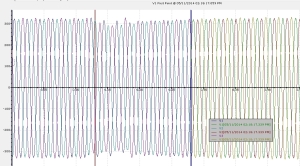It was reported that the voltage disturbance (lasting about 100ms) yesterday at about 1418hrs was caused by lightning affecting the inter-connector link between Singapore and Johor, Malaysia. Link from the statement by SP PowerGrid.
(FYI: Singapore is inter-connected to Johor at 230kV – a transmission level voltage; any disturbance at this level will typically be ‘seen’ by everyone in Singapore with 1/4 of the island ‘seeing’ the worst dip values).
While there is hardly any blackout moments in Singapore due to how the grid is designed and operated here, voltage dips like the above can actually be quite common. In the last 6 months, there has been 3 of such transmission level-originated voltage disturbances (as taken from our monitoring records; 5/11, 10/9 and 27/7). As electrical faults in the grid (be it caused by cable damage, customer’s installation fault, utility equipment fault or lightning) cannot be totally eliminated (only reduced thru rigorous maintenance, regulations/enforcement etc), customers with sensitive equipment should take measures in protecting their equipment adequately. They should also be aware of this Clause in the Transmission Code (which is also in their Connection Agreement with the Utility).

This clause basically rules out any ‘compensation claim’ from the Utility due to losses sustained arising from voltage dips. To some, this may seem ‘cruel’, but I believed this clause is fair as the electrical network is interconnected and everyone (Customers, Utility, Gencos) has to play their part. From my experience, the awareness on the need and know-how for protection against voltage dip is still very much work-in-progress here in Singapore. The key to solve voltage-dip related problems is not to seek compensations, but rather to undertake a proper assessment on the vulnerabilities of their equipment against voltage dips and then invest in the right mitigation solutions / methods.
“Explaining the outage, SGX said power is supplied to the data centre from two separate substations, which is then connected to the individual UPS systems. A “momentary fluctuation in power supply from the substations” caused the UPS systems to switch to its internal power source, but these power sources malfunctioned.” – ChannelNewsAsia.

